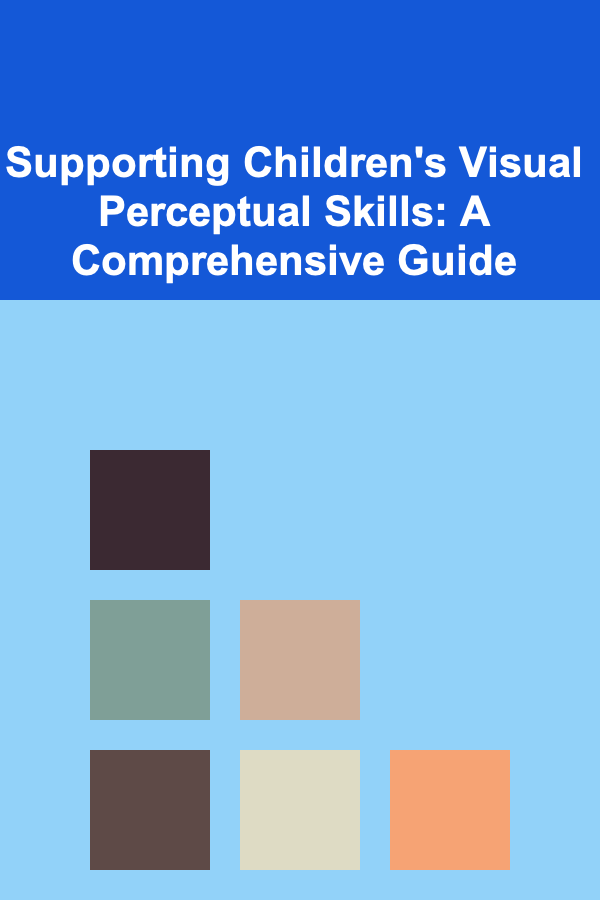
Supporting Children's Visual Perceptual Skills: A Comprehensive Guide
ebook include PDF & Audio bundle (Micro Guide)
$12.99$5.99
Limited Time Offer! Order within the next:

Visual perception is a critical set of skills that allows children to interpret and understand information received through their eyes. It's far more than just seeing clearly; it involves the brain's ability to organize, analyze, and make sense of what the eyes see. These skills are fundamental for academic success, social interactions, and everyday tasks. Difficulties in visual perception can manifest in various ways, impacting a child's ability to read, write, learn math, and even navigate their environment. Therefore, understanding and actively supporting the development of these skills is crucial for every child's well-being and potential.
Understanding Visual Perceptual Skills
Visual perceptual skills encompass a range of abilities, each contributing to a child's overall visual understanding. Key components include:
Visual Discrimination
Visual discrimination is the ability to recognize differences and similarities between objects, shapes, colors, and letters. It's the foundation for distinguishing between a 'b' and a 'd', noticing subtle variations in patterns, and identifying objects hidden within a busy background. A child with poor visual discrimination might struggle to differentiate between similar-looking letters or numbers, have difficulty sorting objects, or find it challenging to recognize familiar faces in a crowd.
Visual Memory
Visual memory is the ability to remember visual information after it is no longer present. This includes remembering the shape of a letter, the layout of a room, or the sequence of steps in a task. Children with weak visual memory may have trouble recalling what they've seen on a page, following multi-step instructions, or visualizing objects they've previously encountered. This can significantly impact reading comprehension, spelling, and problem-solving abilities.
Visual-Spatial Relationships
Visual-spatial relationships refer to the ability to understand the positions of objects in relation to oneself and other objects. This includes understanding concepts like direction (up, down, left, right), distance (near, far), and spatial arrangements. Children need strong visual-spatial skills to understand maps, puzzles, geometry, and even to estimate distances accurately. Difficulties can manifest as problems with writing letters in the correct direction, difficulty understanding math concepts involving spatial reasoning, or clumsiness due to misjudging distances.
Visual Form Constancy
Visual form constancy is the ability to recognize that an object remains the same even when its size, shape, or orientation changes. For example, understanding that a letter 'A' is still an 'A' whether it's printed in uppercase or lowercase, tilted to the side, or written in a different font. This skill is vital for reading fluency, as children need to recognize letters and words regardless of how they are presented. Challenges in this area might lead to difficulties recognizing words when they appear in different fonts or sizes, or difficulty copying shapes accurately.
Visual Sequential Memory
Visual sequential memory is the ability to remember a sequence of visual information in the correct order. This is particularly important for reading (remembering the order of letters in a word), spelling, and following multi-step visual instructions. A child struggling with this skill may misspell words, reverse letters in a sequence, or have difficulty remembering the order of steps in a visual task, such as building a Lego model from instructions.
Visual Closure
Visual closure is the ability to recognize an object even when it is incomplete or partially hidden. This allows us to quickly identify familiar objects even if we only see a portion of them. It's essential for reading comprehension, problem-solving, and quick object recognition. Children with poor visual closure might struggle to identify objects that are partially covered, have difficulty completing puzzles with missing pieces, or misinterpret incomplete words or sentences.
Visual Figure-Ground Discrimination
Visual figure-ground discrimination is the ability to distinguish an object (the figure) from its background (the ground). This skill is crucial for focusing attention on what is important and ignoring distractions. In a classroom setting, this means being able to focus on the teacher while ignoring the other students moving around. Difficulties can manifest as trouble finding specific items in a cluttered drawer, focusing on a worksheet when there are distracting images in the background, or reading from a page with a busy pattern.
Why are Visual Perceptual Skills Important?
The development of strong visual perceptual skills is crucial for a child's overall development and success in various aspects of life:
- Academic Performance: Reading, writing, spelling, and mathematics all heavily rely on visual perceptual skills. The ability to discriminate letters, remember words, understand spatial relationships, and copy accurately are all essential for academic success.
- Social Interactions: Recognizing facial expressions, interpreting body language, and understanding social cues are all reliant on visual perception. Children need these skills to navigate social situations and build healthy relationships.
- Motor Skills: Hand-eye coordination, balance, and spatial awareness are all influenced by visual perception. These skills are important for activities like sports, drawing, and even simple tasks like buttoning a shirt.
- Everyday Tasks: Visual perceptual skills are essential for navigating the environment, finding objects, following instructions, and performing everyday tasks like setting the table or getting dressed.
- Cognitive Development: Developing strong visual perceptual skills enhances overall cognitive development, improving problem-solving abilities, memory, and attention span.
Identifying Potential Difficulties
While every child develops at their own pace, certain signs may indicate potential challenges with visual perceptual skills. It's important to note that exhibiting one or two of these signs doesn't automatically mean a child has a visual perceptual deficit, but consistent observation and professional evaluation are recommended if concerns persist.
- Reversing letters or numbers (e.g., b/d, p/q, 6/9) beyond the expected age range (typically past age 7).
- Difficulty distinguishing between similar-looking letters or words (e.g., "was" and "saw," "on" and "no").
- Trouble copying from the board or a book.
- Poor handwriting or drawing skills.
- Difficulty staying within the lines when coloring or writing.
- Struggling with puzzles or mazes.
- Clumsiness or difficulty with hand-eye coordination.
- Difficulty remembering what they've read or seen.
- Trouble following multi-step instructions.
- Difficulty organizing their desk or belongings.
- Sensitivity to bright lights or visual clutter.
- Complaints of eye strain or headaches after reading or other visually demanding tasks.
- Difficulty finding objects in a cluttered environment.
- Challenges with tasks involving spatial reasoning (e.g., geometry, map reading).
If you notice several of these signs and have concerns about your child's visual perceptual skills, it's crucial to seek professional evaluation from an optometrist specializing in vision therapy, an occupational therapist, or a developmental pediatrician. Early identification and intervention can significantly improve a child's developmental trajectory.
Strategies and Activities to Support Visual Perceptual Skills
Fortunately, there are numerous fun and engaging activities that parents, educators, and therapists can use to support the development of visual perceptual skills in children. These activities can be incorporated into daily routines, playdates, or classroom settings. It's important to tailor the activities to the child's age, developmental level, and specific areas of need.
General Strategies for Promoting Visual Perception
- Create a visually organized environment: Minimize clutter and distractions to help children focus on relevant visual information. Use clear labels and organization systems.
- Provide good lighting: Ensure adequate and appropriate lighting for reading, writing, and other visually demanding tasks. Avoid glare and flickering lights.
- Encourage proper posture and visual habits: Teach children to maintain good posture while reading or writing, and to take breaks to rest their eyes.
- Use multi-sensory learning approaches: Engage multiple senses (sight, touch, hearing, movement) to reinforce visual information. For example, tracing letters in sand, building shapes with blocks, or listening to audiobooks while following along with the text.
- Break down tasks into smaller steps: For children who struggle with visual processing, breaking down complex tasks into smaller, more manageable steps can reduce overwhelm and improve success.
- Provide positive reinforcement and encouragement: Celebrate successes and encourage effort, even if progress is slow. Focus on the child's strengths and provide support in areas where they struggle.
- Consult with professionals: Don't hesitate to seek guidance from an optometrist specializing in vision therapy, an occupational therapist, or a developmental pediatrician if you have concerns about your child's visual perceptual skills.
Activities to Enhance Specific Visual Perceptual Skills
Visual Discrimination Activities
- Matching games: Use matching cards with pictures, shapes, letters, or numbers. Start with simple matches and gradually increase the complexity. Memory games also help with visual discrimination and memory.
- Sorting activities: Sort objects by color, shape, size, or other attributes. Use a variety of materials, such as toys, beads, buttons, or household items.
- "I Spy" games: Play "I Spy" with objects in the environment, focusing on specific attributes like color, shape, or size. "I spy with my little eye something that is blue and round."
- Letter and number hunts: Hide letters or numbers in a picture or room and have the child find them. This encourages visual scanning and discrimination.
- Spot the difference puzzles: Use "Spot the Difference" puzzles to encourage careful observation and visual discrimination.
- Shape Sorters: Shape sorters for younger children are excellent for developing visual discrimination of shapes.
Visual Memory Activities
- "What's Missing?" game: Show the child a collection of objects, then remove one object and ask them to identify what's missing.
- Kim's Game: Show a tray of objects for a brief period, then cover it. Ask the child to recall as many objects as they can.
- Picture recall: Show the child a picture for a short time, then remove it and ask them to describe what they saw. Gradually increase the complexity of the pictures.
- Following visual directions: Give the child visual directions to follow, such as drawing a specific pattern or arranging objects in a particular order.
- Memory card games: Play memory card games that require matching pairs of images.
- Storytelling with visuals: Use pictures or drawings to tell a story, then ask the child to retell the story using the visuals as prompts.
Visual-Spatial Relationship Activities
- Puzzles: Start with simple puzzles and gradually increase the complexity. Puzzles help develop spatial reasoning and problem-solving skills.
- Building blocks: Encourage the child to build structures with blocks, following instructions or creating their own designs.
- Obstacle courses: Create obstacle courses that require the child to navigate space and judge distances. Use household items or outdoor equipment.
- Map reading: Introduce the child to maps and help them understand how to orient themselves and find locations. Start with simple maps and gradually increase the complexity.
- Following directions with prepositions: Give the child directions using prepositions (e.g., "Put the ball under the table," "Place the book next to the lamp").
- Simon Says with spatial commands: Play Simon Says incorporating spatial awareness such as, "Simon says put your hand above your head," or "Simon says step behind the chair."
Visual Form Constancy Activities
- Recognizing letters and numbers in different fonts and sizes: Use flashcards or worksheets with letters and numbers printed in various fonts and sizes.
- Matching shapes and objects presented in different orientations: Present shapes or objects in different orientations and ask the child to match them to a target shape or object.
- Drawing shapes and letters from memory: Ask the child to draw shapes and letters from memory, focusing on maintaining the correct form regardless of size or orientation.
- Playing with Tangrams: Tangrams require children to manipulate shapes and recognize them in different orientations to form a larger picture.
Visual Sequential Memory Activities
- Copying patterns or sequences: Show the child a pattern or sequence of colors, shapes, or objects, then ask them to copy it.
- Following multi-step visual instructions: Give the child multi-step visual instructions to follow, such as building a Lego model or completing a craft project.
- Recalling a sequence of events from a story: Read a story to the child, then ask them to retell the story, focusing on remembering the sequence of events. Use pictures as prompts if needed.
- Playing "Simon" with a visual component: Use colored lights or shapes in a sequence and have the child repeat the sequence.
- Stringing beads in a specific order: Provide a visual pattern for a bead necklace or bracelet and have the child replicate it.
Visual Closure Activities
- Completing incomplete pictures: Provide the child with incomplete pictures and ask them to fill in the missing parts.
- Identifying objects that are partially hidden: Show the child objects that are partially hidden and ask them to identify them.
- Working on dot-to-dot puzzles: Dot-to-dot puzzles require visual closure to recognize the final image.
- Using worksheets with overlapping shapes or figures: Have the child identify the individual shapes or figures within the overlapping design.
Visual Figure-Ground Discrimination Activities
- Finding hidden pictures: Use hidden picture puzzles to encourage the child to focus on the target object while ignoring the surrounding background.
- Word searches: Word searches require the child to identify specific words within a grid of letters.
- Finding specific objects in a cluttered environment: Ask the child to find specific objects in a cluttered drawer or room.
- Using worksheets with images superimposed on patterned backgrounds: Have the child identify the images within the distracting background.
- Mazes: Navigating mazes requires the child to focus on the path while ignoring the surrounding walls and distractions.
The Role of Technology
Technology can be a valuable tool for supporting visual perceptual skills. Many apps and websites offer interactive games and activities that can target specific areas of need. However, it's important to use technology judiciously and to ensure that screen time is balanced with other activities that promote visual and physical development.
Examples of helpful apps and websites include:
- Visual Attention Therapy (apps): Many apps are designed to improve visual attention and figure-ground discrimination.
- Shape and Pattern Recognition Apps: Several apps cater to children's shape recognition and pattern identification abilities.
- Online Puzzle Games: Numerous websites offer online puzzles of varying difficulty levels.
It's crucial to carefully evaluate the apps and websites before using them, ensuring that they are age-appropriate, engaging, and aligned with the child's specific needs. Also, remember that digital tools should complement, not replace, traditional activities that promote visual perceptual skills.
Conclusion
Supporting children's visual perceptual skills is an investment in their future. By understanding the components of visual perception, identifying potential difficulties, and implementing targeted strategies and activities, parents, educators, and therapists can play a vital role in helping children develop the visual skills they need to succeed in school, social interactions, and everyday life. Early intervention and consistent support can make a significant difference in a child's developmental trajectory, empowering them to reach their full potential. Remember that a holistic approach, incorporating various activities and professional guidance when needed, is key to fostering strong visual perceptual abilities in children.

How to Build an Effective Content Team to Execute Your Strategy
Read More
How to Create a Checklist for Choosing the Perfect Venue for Your Fundraising Event
Read More
How to Design a Team Building Activities Checklist for Conflict Resolution
Read More
How to Write About Trends and Predictions
Read More
How to Understand Warp Drive (Conceptual)
Read More
How to Choose Organic vs. Conventional Produce
Read MoreOther Products

How to Build an Effective Content Team to Execute Your Strategy
Read More
How to Create a Checklist for Choosing the Perfect Venue for Your Fundraising Event
Read More
How to Design a Team Building Activities Checklist for Conflict Resolution
Read More
How to Write About Trends and Predictions
Read More
How to Understand Warp Drive (Conceptual)
Read More